Capturing Flood Risk Perception via Sketch Maps
Abstract
:1. Introduction
2. Related Work
2.1. Flood Risk Perception
2.2. Capturing of Risk Perception
3. Methods
3.1. Sketch Maps
3.2. Questionnaires
3.3. Combination of Sketch Maps and Questionnaires
3.4. Case Study Design
3.5. Reference Data
4. Case Studies in Santiago de Chile
5. Results
5.1. Case Study in Quilicura, Santiago de Chile
5.1.1. Comparison to Visual Inspections
5.1.2. Comparison to Local Flood Risk Perception
5.2. Case Study in La Florida, Santiago de Chile
5.2.1. Comparison to Critical Points Assessed by the Local Government
5.2.2. Characteristics of Participants
6. Discussion
6.1. Opportunities
6.2. Challenges
7. Conclusions
Author Contributions
Funding
Acknowledgments
Conflicts of Interest
References
- Douglas, I.; Garvin, S.; Lawson, N.; Richards, J.; Tippett, J.; White, I. Urban pluvial flooding: A qualitative case study of cause, effect and nonstructural mitigation. J. Flood Risk Manag. 2010, 3, 112–125. [Google Scholar] [CrossRef]
- Ebert, A.; Banzhaf, E.; McPhee, J. The influence of urban expansion on the flood hazard in Santiago de Chile. In Proceedings of the 2009 Joint Urban Remote Sensing Event, Shanghai, China, 20–22 May 2009; pp. 1–7. [Google Scholar]
- Wagner, K. Mental models of flash floods and landslides. Risk Anal. 2007, 27, 671–682. [Google Scholar] [CrossRef] [PubMed]
- European Commission. The EU Floods Directive. Available online: http://ec.europa.eu/environment/water/flood_risk/ (accessed on 8 June 2018).
- Gharesifard, M.; Wehn, U. To share or not to share: Drivers and barriers for sharing data via online amateur weather networks. J. Hydrol. 2016, 535, 181–190. [Google Scholar] [CrossRef]
- Wehn, U.; Rusca, M.; Evers, J.; Lanfranchi, V. Participation in flood risk management and the potential of citizen observatories: A governance analysis. Environ. Sci. Policy 2015, 48, 225–236. [Google Scholar] [CrossRef]
- Klonner, C.; Marx, S.; Usón, T.; Porto de Albuquerque, J.; Höfle, B. Volunteered geographic information in natural hazard analysis: A systematic literature review of current approaches with a focus on preparedness and mitigation. ISPRS Int. J. Geo-Inf. 2016, 5, 103. [Google Scholar] [CrossRef]
- Assumpção, T.H.; Popescu, I.; Jonoski, A.; Solomatine, D.P. Citizen observations contributing to flood modelling: Opportunities and challenges. Hydrol. Earth Syst. Sci. 2018, 22, 1473–1489. [Google Scholar] [CrossRef]
- Aerts, J.C.J.H.; Botzen, W.J.; Clarke, K.C.; Cutter, S.L.; Hall, J.W.; Merz, B.; Michel-Kerjan, E.; Mysiak, J.; Surminski, S.; Kunreuther, H. Integrating human behaviour dynamics into flood disaster risk assessment. Nat. Clim. Chang. 2018, 8, 193–199. [Google Scholar] [CrossRef] [Green Version]
- Schnebele, E.; Cervone, G. Improving remote sensing flood assessment using volunteered geographical data. Nat. Hazard Earth Syst. Sci. 2013, 13, 669–677. [Google Scholar] [CrossRef] [Green Version]
- Degrossi, L.C.; Porto De Albuquerque, J.; Fava, M.C.; Mendiondo, E.M. Flood citizen observatory: A crowdsourcing-based approach for flood risk management in Brazil. In Proceedings of the International Conference on Software Engineering and Knowledge Engineering, Hyatt Regency, Vancouver, BC, Canada, 1–3 July 2014; pp. 570–575. [Google Scholar]
- O’Neill, E.; Brennan, M.; Brereton, F.; Shahumyan, H. Exploring a spatial statistical approach to quantify flood risk perception using cognitive maps. Nat. Hazards 2015, 76, 1573–1601. [Google Scholar] [CrossRef]
- Klonner, C.; Marx, S.; Usón, T.; Höfle, B. Risk awareness maps of urban flooding via OSM Field Papers-case study Santiago de Chile. In Proceedings of the 13th International Conference on Information Systems for Crisis Response and Management, Rio de Janeiro, Brazil, 22–25 May 2016; Tapia, A., Antunes, P., Bañuls, V.A., Moore, K., Porto, J., Eds.; Federal University of Rio de Janeiro: Rio de Janeiro, Brazil, 2016. [Google Scholar]
- Boschmann, E.E.; Cubbon, E. Sketch maps and qualitative GIS: Using cartographies of individual spatial narratives in geographic research. Prof. Geogr. 2014, 66, 236–248. [Google Scholar] [CrossRef]
- Gaillard, J.C.; Mercer, J. From knowledge to action: Bridging gaps in disaster risk reduction. Prog. Hum. Geog. 2013, 37, 93–114. [Google Scholar] [CrossRef]
- Herget, J. Hochwasser, Sturzfluten und Ausbruchsflutwellen. In Naturrisiken und Sozialkatastrophen; Felgentreff, C., Glade, T., Eds.; Spektrum Akademischer Verlag: Berlin/Heidelberg, Germany, 2008; pp. 165–172. [Google Scholar]
- Banzhaf, E.; Kindler, A.; Müller, A.; Metz, K.; Reyes-Paecke, S.; Weiland, U. Land-use change, risk and land-use management. In Risk Habitat Megacity; Springer: Berlin/Heidelberg, Germany, 2012; pp. 127–154. [Google Scholar]
- Lynch, K. The Image of the City; MIT Press: Cambridge, MA, USA, 1960. [Google Scholar]
- Blades, M. The reliability of data collected from sketch maps. J. Environ. Psychol. 1990, 10, 327–339. [Google Scholar] [CrossRef]
- Haklay, M. Citizen science and volunteered geographic information: Overview and typology of participation. In Crowdsourcing Geographic Knowledge; Sui, D., Elwood, S., Goodchild, M., Eds.; Springer: Dordrecht, The Netherlands, 2013; pp. 105–122. [Google Scholar]
- Haworth, B.; Whittaker, J.; Bruce, E. Assessing the application and value of participatory mapping for community bushfire preparation. Appl. Geogr. 2016, 76, 115–127. [Google Scholar] [CrossRef]
- Haworth, B.T. Implications of volunteered geographic information for disaster management and GIScience: A more complex world of volunteered geography. Ann. Am. Assoc. Geogr. 2018, 108, 226–240. [Google Scholar] [CrossRef]
- Samodra, G.; Chen, G.; Sartohadi, J.; Kasama, K. Generating landslide inventory by participatory mapping: An example in Purwosari Area, Yogyakarta, Java. Geomorphology 2015. [Google Scholar] [CrossRef]
- Silvestro, F.; Gabellani, S.; Giannoni, F.; Parodi, A.; Rebora, N.; Rudari, R.; Siccardi, F. A hydrological analysis of the 4 November 2011 event in Genoa. Nat. Hazard Earth Syst. Sci. 2012, 12, 2743–2752. [Google Scholar] [CrossRef] [Green Version]
- Cheung, W.; Houston, D.; Schubert, J.E.; Basolo, V.; Feldman, D.; Matthew, R.; Sanders, B.F.; Karlin, B.; Goodrich, K.A.; Contreras, S.L.; et al. Integrating resident digital sketch maps with expert knowledge to assess spatial knowledge of flood risk: A case study of participatory mapping in Newport Beach, California. Appl. Geogr. 2016, 74, 56–64. [Google Scholar] [CrossRef] [Green Version]
- Curtis, J.W.; Shiau, E.; Lowery, B.; Sloane, D.; Hennigan, K.; Curtis, A. The prospects and problems of integrating sketch maps with geographic information systems to understand environmental perception: A case study of mapping youth fear in Los Angeles gang neighborhoods. Environ. Plan. B Plan. Des. 2014, 41, 251–271. [Google Scholar] [CrossRef]
- Ceccato, V.A.; Snickars, F. Adapting GIS technology to the needs of local planning. Environ. Plan. B Plan. Des. 2000, 27, 923–937. [Google Scholar] [CrossRef]
- Campbell, E.; Henly, J.R.; Elliott, D.S.; Irwin, K. Subjective constructions of neighborhood boundaries: Lessons from a qualitative study of four neighborhoods. J. Urban Aff. 2009, 31, 461–490. [Google Scholar] [CrossRef]
- Elwood, S.; Goodchild, M.F.; Sui, D.Z. Researching volunteered geographic information: Spatial data, geographic research, and new social practice. Ann. Assoc. Am. Geogr. 2012, 102, 571–590. [Google Scholar] [CrossRef]
- Felgentreff, C.; Glade, T. Naturrisiken und Sozialkatastrophen; Spektrum Akademischer Verlag: Berlin/Heidelberg, Germany, 2008; pp. XVIII, 454. [Google Scholar]
- Field Papers. Field Papers. Available online: http://fieldpapers.org/ (accessed on 8 June 2018).
- KoBo Toolbox. Kobo Toolbox. Available online: http://www.kobotoolbox.org/ (accessed on 8 June 2018).
- Mocnik, F.-B.; Mobasheri, A.; Griesbaum, L.; Eckle, M.; Jacobs, C.; Klonner, C. A grounding-based ontology of data quality measures. JOSIS 2018, 16. [Google Scholar] [CrossRef]
- Stake, R.E. Case studies. In Handbook of Qualitative Research; Denzin, N.K., Lincoln, Y.S., Eds.; Sage: London, UK, 1994. [Google Scholar]
- Malterud, K.; Siersma, V.D.; Guassora, A.D. Sample size in qualitative interview studies: Guided by information power. Qual. Health Res. 2016, 26, 1753–1760. [Google Scholar] [CrossRef] [PubMed]
- Punch, K.F. Introduction to Social Research: Quantitative and Qualitative Approaches, 1st ed.; Sage: London, UK, 1998. [Google Scholar]
- Sandelowski, M. Sample size in qualitative research. Res. Nurs. Health 1995, 18, 179–183. [Google Scholar] [CrossRef] [PubMed] [Green Version]
- Wachinger, G.; Renn, O.; Begg, C.; Kuhlicke, C. The risk perception paradox—Implications for governance and communication of natural hazards. Risk Anal. 2013, 33, 1049–1065. [Google Scholar] [CrossRef] [PubMed]
- Usón, T.J.; Klonner, C.; Höfle, B. Using participatory geographic approaches for urban flood risk in Santiago de Chile: Insights from a governance analysis. Environ. Sci. Policy 2016, 66, 62–72. [Google Scholar] [CrossRef]
- Gallart, F.; Llorens, P.; Latron, J.; Cid, N.; Rieradevall, M.; Prat, N. Validating alternative methodologies to estimate the regime of temporary rivers when flow data are unavailable. Sci. Total Environ. 2016, 565, 1001–1010. [Google Scholar] [CrossRef] [PubMed]
- Fonte, C.C.; Antoniou, V.; Bastin, L.; Estima, J.; Arsanjani, J.J.; Bayas, J.-C.L.; See, L.; Vatseva, R. Assessing VGI data quality. In Mapping and the Citizen Sensor; Foody, G., See, L., Fritz, S., Mooney, P., Olteanu-Raimond, A.-M., Fonte, C.C., Antoniou, V., Eds.; Ubiquity Press: London, UK, 2017. [Google Scholar]
- Goodchild, M.F.; Li, L. Assuring the quality of volunteered geographic information. Spat. Stat. 2012, 1, 110–120. [Google Scholar] [CrossRef]
- Haklay, M. How good is volunteered geographical information? A comparative study of OpenStreetMap and Ordnance Survey datasets. Environ. Plan. B Plan. Des. 2010, 37, 682–703. [Google Scholar] [CrossRef]
- Marana, P.; Labaka, L.; Sarriegi, J.M. A framework for public-private-people partnerships in the city resilience-building process. Saf. Sci. 2017. [Google Scholar] [CrossRef]
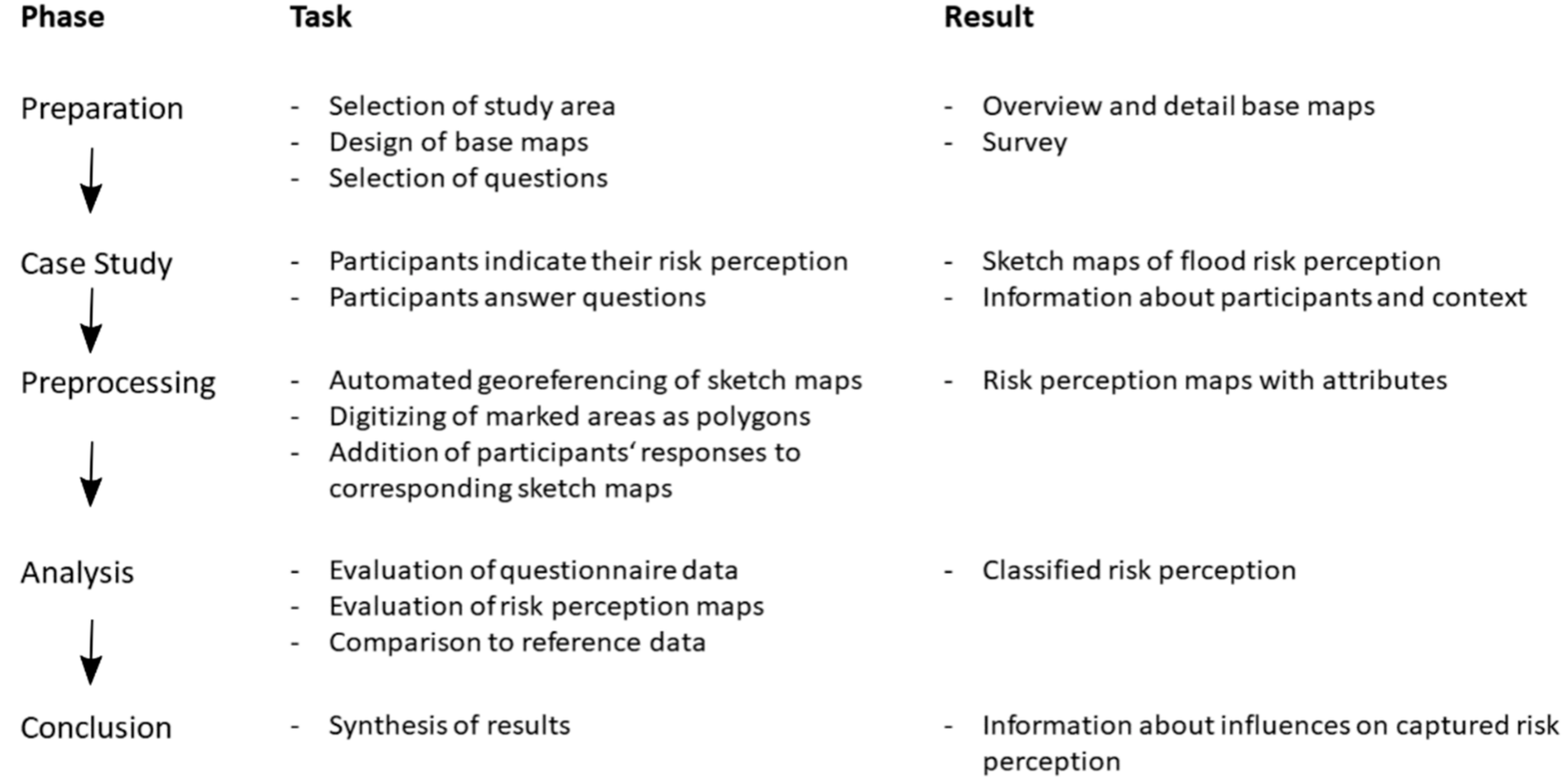

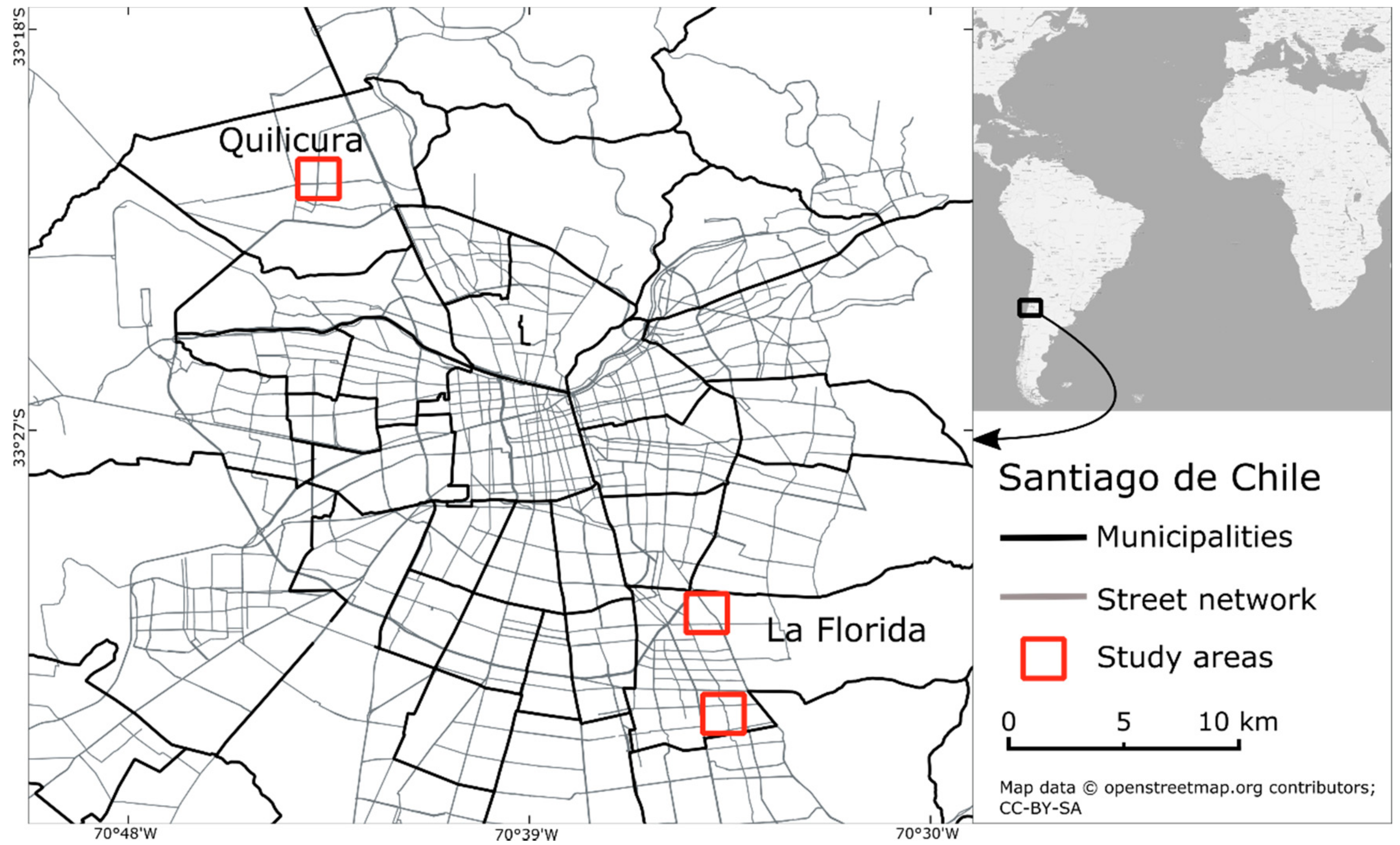
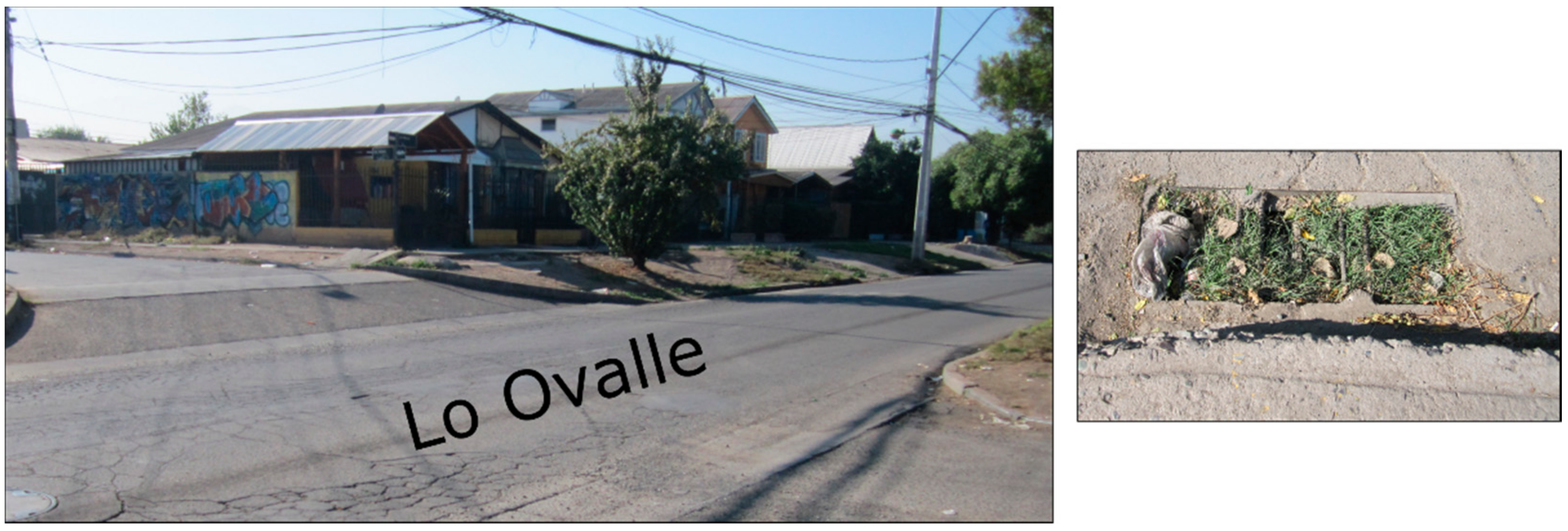
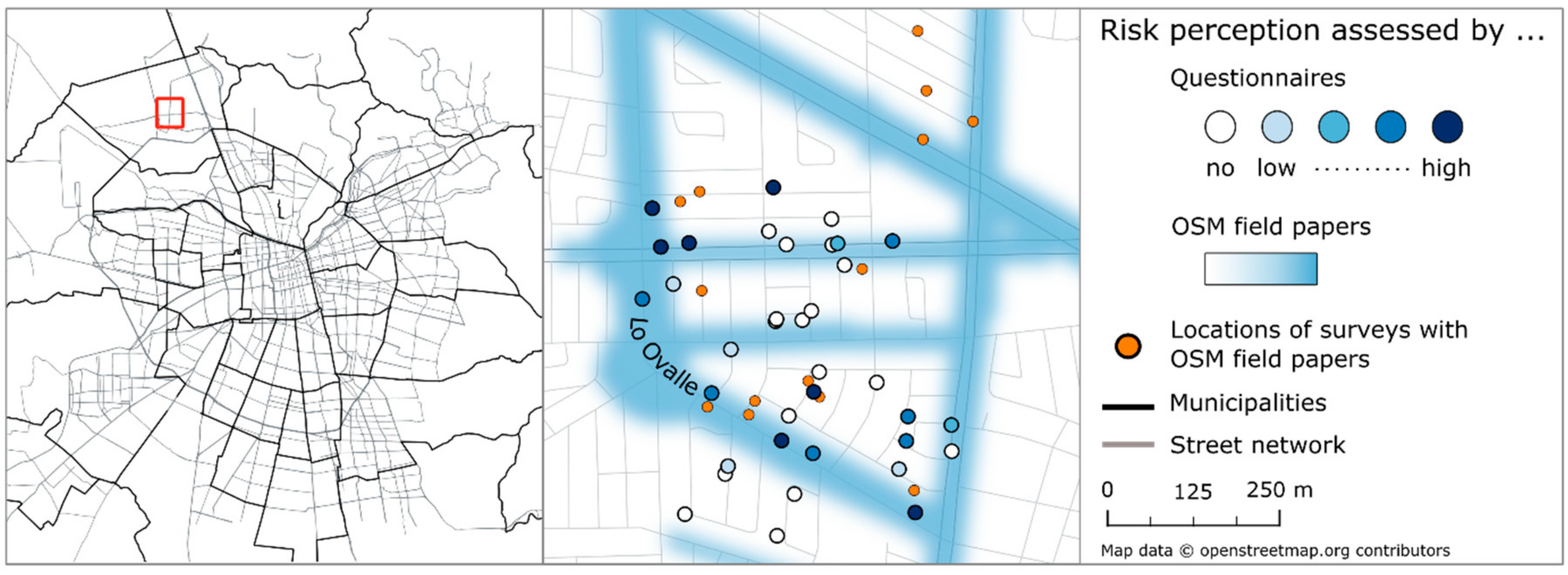
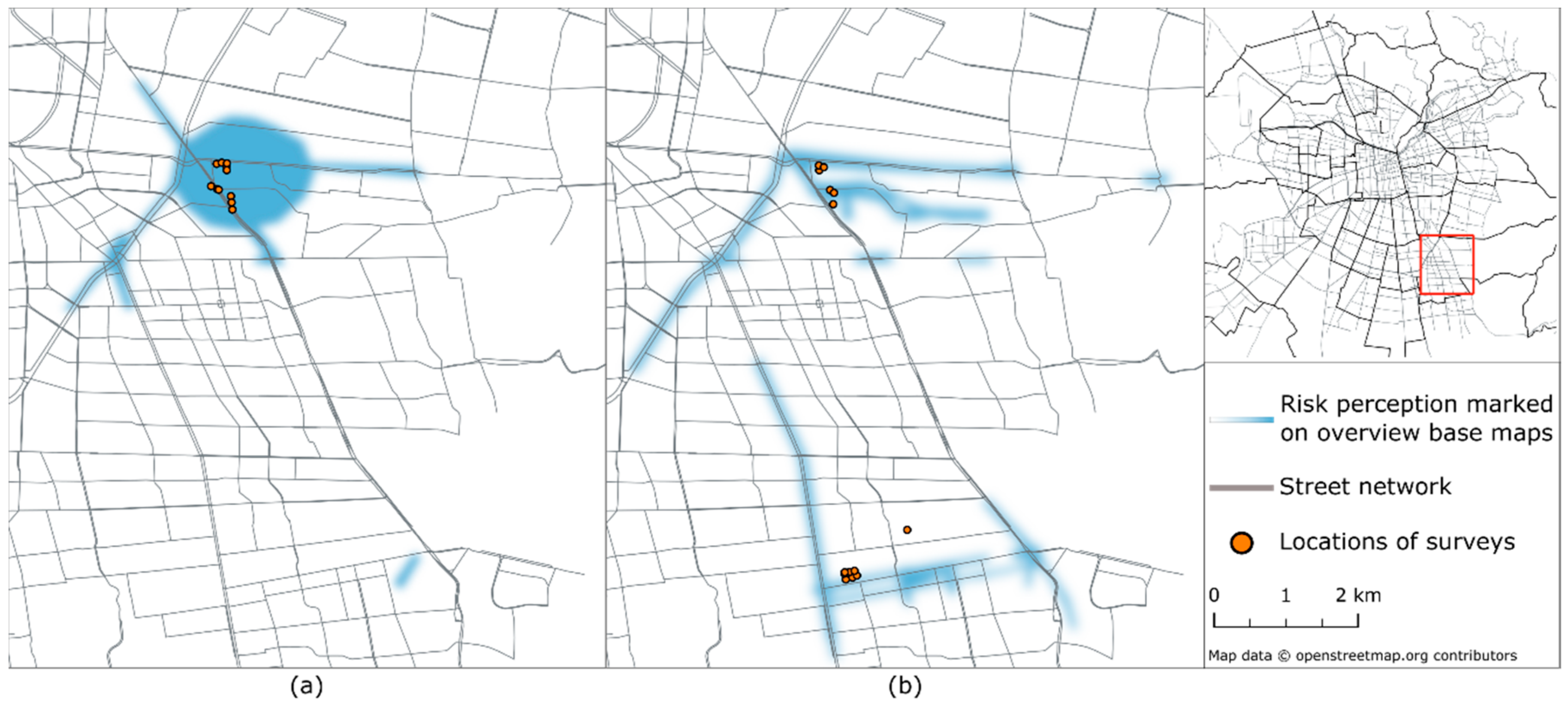
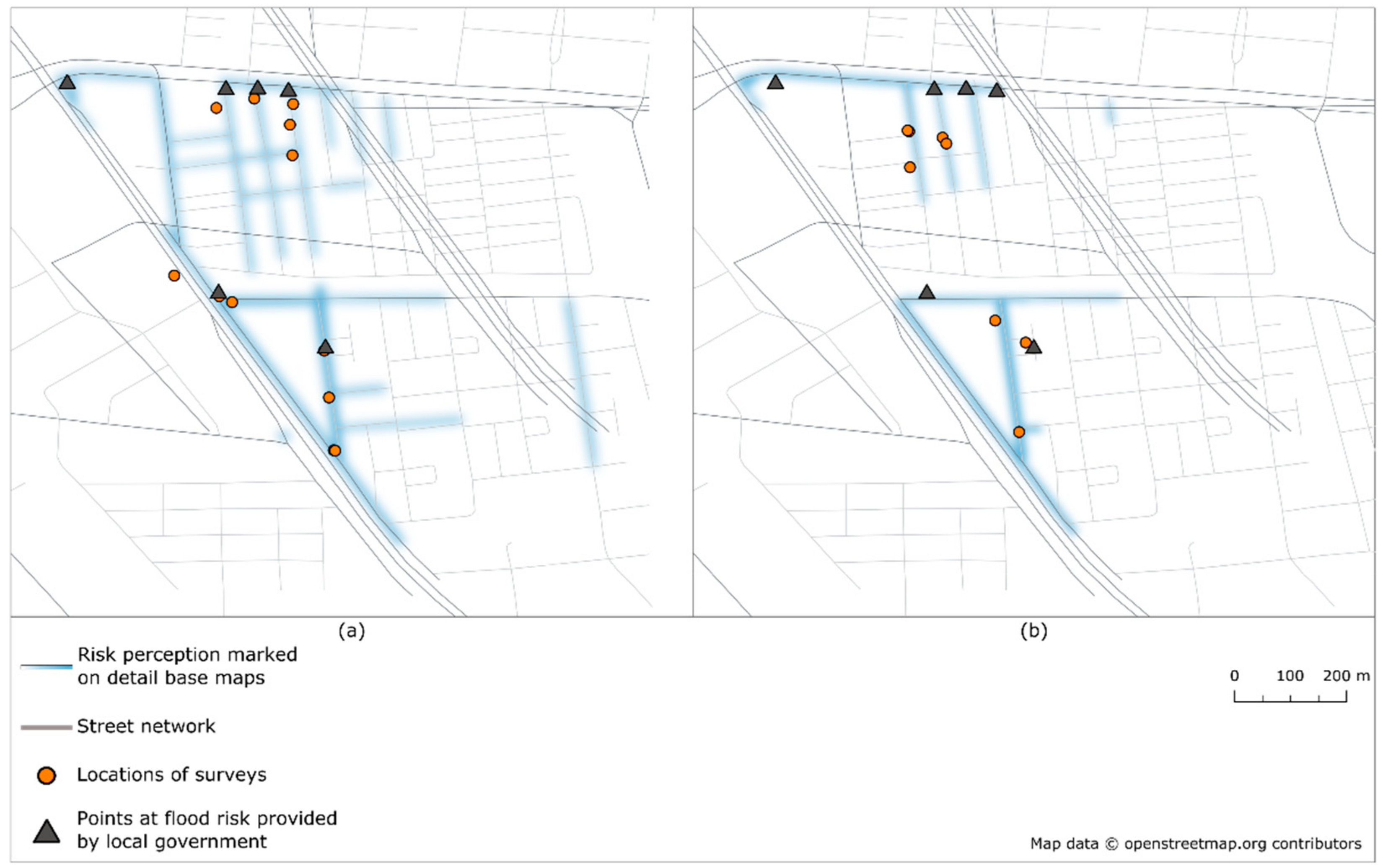
| Affectedness | Residents (18) (Average: 3.83) | Pedestrians (12) (Average: 3.58) |
|---|---|---|
| 1 (not affected) | 0 | 0 |
| 2 | 4 | 2 |
| 3 | 2 | 5 |
| 4 | 5 | 1 |
| 5 (extremely affected) | 7 | 4 |
| Affectedness | Residents (18) (Average: 3.56) | Pedestrians (12) (Average: 3.58) |
|---|---|---|
| 1 (not affected) | 2 | 2 |
| 2 | 3 | 2 |
| 3 | 1 | 0 |
| 4 | 7 | 3 |
| 5 (extremely affected) | 5 | 5 |
| Opportunities | Challenges |
|---|---|
|
|
|
|
|
|
|
|
|
|
| |
|
© 2018 by the authors. Licensee MDPI, Basel, Switzerland. This article is an open access article distributed under the terms and conditions of the Creative Commons Attribution (CC BY) license (http://creativecommons.org/licenses/by/4.0/).
Share and Cite
Klonner, C.; Usón, T.J.; Marx, S.; Mocnik, F.-B.; Höfle, B. Capturing Flood Risk Perception via Sketch Maps. ISPRS Int. J. Geo-Inf. 2018, 7, 359. https://doi.org/10.3390/ijgi7090359
Klonner C, Usón TJ, Marx S, Mocnik F-B, Höfle B. Capturing Flood Risk Perception via Sketch Maps. ISPRS International Journal of Geo-Information. 2018; 7(9):359. https://doi.org/10.3390/ijgi7090359
Chicago/Turabian StyleKlonner, Carolin, Tomás J. Usón, Sabrina Marx, Franz-Benjamin Mocnik, and Bernhard Höfle. 2018. "Capturing Flood Risk Perception via Sketch Maps" ISPRS International Journal of Geo-Information 7, no. 9: 359. https://doi.org/10.3390/ijgi7090359





